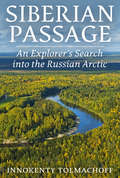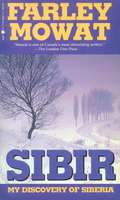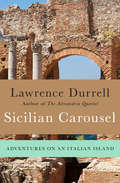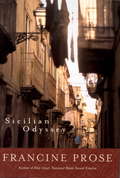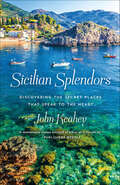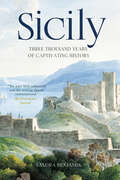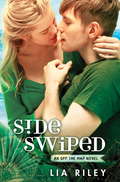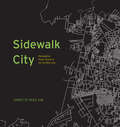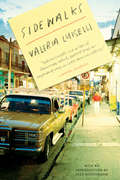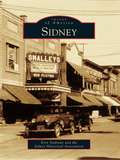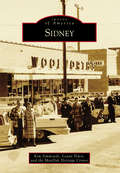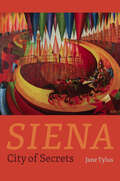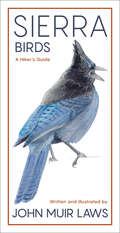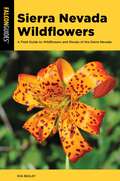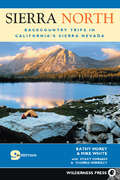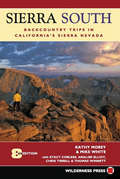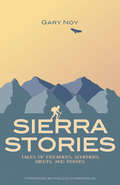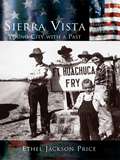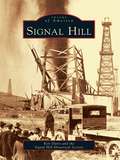- Table View
- List View
Siberian Passag: An Explorer's Search into the Russian Arctic
by Innokenty TolmachoffSiberian Passage, first published in 1949, is a fascinating look at the land and peoples of far northern Russia in the early 1900s. The author was a member of a Russian scientific expedition which explored the then little known boreal and arctic regions of Siberia, and describes the lives of the natives they encountered, travels by dog-sled, dealing with the many difficulties in travel, including wild extremes in temperature, and provides an insightful overview of the region.
Sibir: My Discovery of Siberia
by Farley MowatHere is a Siberia unheard of in the West. Once the most remote place of exile in all of Russia, Mowat describes it as a burgeoning land of opportunity and growth. Granted extraordinary freedom to visit places rarely seen by any westerner since 1917, Farley Mowat and his wife, Claire, travelled more than 29,000 miles over mountains, steppes, taiga and tundra to meet the people who have chosen to make Siberia their home and livelihood. With his classic exuberance and wit, Mowat brings to life a place and a people who share the top of the world with us – their hopes and aspirations, their humour, and their dedication to the dramatic awakening of Sibir, the Sleeping land. From the Hardcover edition.
Sicilian Carousel: Adventures on an Italian Island
by Lawrence DurrellA moving account of friendship and discovery on the island of Sicily from the acclaimed travel writer and bestselling author of The Alexandria Quartet. Despite decades spent writing poetic evocations of the timeless pleasures of life in the Mediterranean, Lawrence Durrell had never set foot on the sea&’s largest island: mysterious, impenetrable Sicily. For years his friend Martine begged him to visit her on this sun-kissed paradise, and though he always intended to, life inevitably interfered. It took Martine&’s sudden death to finally bring him to the island&’s shores. With Martine&’s letters in his pocket, Durrell signs up for a tour group, hoping to learn the travel habits of those who aren&’t obsessively devoted to island life. As he treks from sight to sight, dizzy with history and culture, Durrell finds echoes of his past lives in Rhodes, Cyprus, and Corfu.
Sicilian Odyssey
by Francine ProseA blending of art and cultural criticism, travel writing, and personal narrative, Sicilian Odyssey is Francine Prose's imaginative consideration of the diverse cultural legacies found juxtaposed and entangled on the Mediterranean island of Sicily. Prose examines architectural sites and objects that encapsulate period in the island's rich life and history and looks at the ways in which myth and actuality converge. Exploring the intact and beautiful Greek amphitheaters at Siracusa and Taormina, the cathedral at Monreale, the Roman mosaics at Piazza Armerina, and some of the masterpieces of the Baroque scattered throughout the island, Prose focuses her keen insight to imagine them in their own time, to examine the evolution and decline of the cultures that produced them, and to deconstruct powerful responses each evokes in her. Prose writes of the intensity of Sicily, the "commitment to the extreme," where the history is more colorful, the sun hotter, the cooking earthier, the violence more horrific, the carnival more raucous, the politics more Byzantine than other places on Earth, and how much the island can teach us about the triumph of beauty over violence and life over death. Illuminated by the author's own photographs, Sicilian Odyssey brings exotic and enigmatic Sicily to life through the prism of its past.
Sicilian Odyssey
by Francine ProseA blending of art and cultural criticism, travel writing, and personal narrative, Sicilian Odyssey is Francine Prose's imaginative consideration of the diverse cultural legacies found juxtaposed and entangled on the Mediterranean island of Sicily. She writes of the intensity of Sicily, the "commitment to the extreme," where the history is more colorful, the sun hotter, the cooking earthier, the violence more horrific, the carnival more raucous, the politics more Byzantine than other places on Earth, and how much the island can teach us about the triumph of beauty over violence and life over death. Prose examines architectural sites and objects and looks at the ways in which myth and actuality converge. Exploring the intact and beautiful Greek amphitheaters at Siracusa and Taormina, the cathedral at Monreale, the Roman mosaics at Piazza Armerina, and some of the masterpieces of the Baroque scattered throughout the island, Prose focuses her keen insight to imagine them in their own time, to examine the evolution and decline of the cultures that produced them, and to deconstruct powerful responses each evokes in her.
Sicilian Splendors: Discovering the Secret Places That Speak to the Heart
by John Keahey"A wondrously joyous account of travel as it should be." –Publishers WeeklyA travel narrative that focuses on Sicily's little-known regions, from the author of Seeking Sicily and Hidden Tuscany.From Palermo to Castiglione di Sicilia to Alimena, Sicily holds great secrets from the past and unspoken promises. Tradition, in the form of festivals, the written word, photographs, and song, reverberates through village walls. Now, slowly shaking itself free of the Mafia, Sicily is opening itself up to visitors in ways it never has before.Sicilian Splendors explores the history, politics, food, Mafia, and people which John Keahey encounters throughout his travels during his return to Sicily. Through conversing with natives and immersing himself in culture, Keahey illustrates a brand new Sicily no one has ever talked about before. Villagers, eager to welcome tourism and impart awareness of their cultural background, greet Keahey for meals and drink and walk him through their winding streets. They share stories of well-known writers, such as Maria Messina, who have found inspiration in Sicily’s villages. Keahey’s never-ending curiosity as a traveler shines light on Sicily’s mythical mysteries and portrays the island not only through his eyes but also through Sicily’s heart.This picturesque travel memoir navigates Sicily today and seeks to understand Sicily’s past. In lyrical prose and vivid dialect, Keahey paints images of the island’s villages, people, and culture with careful strokes and a meticulously even hand. Keahey not only serves as a guide through the marvel of Sicily’s identity, but he also looks deeply into Sicily’s soul.
Sicily: The Time Traveler's Guide (The Time Traveler's Guide)
by Louis Mendola Jacqueline AlioIf you want more information about Sicily's long history than what's included in your otherwise-useful guidebook, but you don't want to read a 600-page history tome that ignores the places you would like to see, this book is for you. It will take you from seeing to understanding.Written by two of Sicily's leading historians, this unique guide emphasizes not only the archeology and sights of Sicily but the history behind these fascinating places, including many "secret" details unknown to most travel writers. The book presents a general history of Sicily and a detailed timeline covering three millennia, along with chapters dedicated to things to see in the island's cities and towns.There are chapters on sights, natural attractions (like Mount Etna), food and wine, and other topics. A number of maps and charts are included. The text mentions museums and the main points of interest of each place described. The book's focus is always those places that elicit the greatest curiosity among the majority of visitors. Localities of lesser interest are omitted while the authors concentrate on Erice, Siracusa, Cefalù and other cities known for their history and monuments, and of course archeological sites like Segesta, Agrigento, Selinunte and Himera. They mention a few of the more impressive castles, such as Caccamo, and Baroque jewels like Noto and Ragusa. Palermo and Monreale get their share of attention.Since its focus is history and culture, this guide doesn't present information about hotels, beaches, restaurants and transportation. Its purpose is to complement the guides that offer those details by "completing the picture" of the world's most conquered island for readers seeking more history than what is found in the typical guidebook.Most of this information is drawn from the authors' earlier books and a website (Best of Sicily) for which they have written many articles over the years. In fact, the vast readership of that website, online since 1999, has made Alio and Mendola Sicily's most popular historians, with millions of readers during the last two decades. In scholarly circles, they are called upon to peer review papers for publication in academic journals and several of their books have been used in university courses.Sicily: The Time Traveler's Guide follows the authors' earlier book in this series dedicated to Norman-Arab sites in Palermo, Monreale and Cefalù, as well as their book, The Peoples of Sicily, a popular ethnography. Jackie Alio has written groundbreaking biographies of the medieval queens of Sicily while Lou Mendola wrote a history of the Kingdom of Sicily, among other books. A few of those books, being based on original research, were "firsts" in their fields of study.This is accurate history without the clichés found in some books. Whether they're discussing the Punic Wars, the Sicilian Vespers or Sicilian literature, the authors bring you an understanding of the story behind the stories. Their narratives are captivating yet informative. This book is the extra step for thinking travelers seeking to take their experience to the next level of knowledge.Some travel writers are well-informed about history, but this book is the work of scholars based in Sicily. The information it presents, and the way it is presented, makes this convenient guide a highly insightful source for your discovery of Sicily. As an ebook, it's easy to take with you to read along the way.In print, this book would run to more than 500 pages. In this format, it fits in your pocket or purse. Traveling back in time was never so simple.
Sicily: Three Thousand Years of Human History
by Sandra BenjaminTake a tour through the Mediterranean&’s largest island in this fascinating history of Sicily for armchair travelers, history buffs, and anyone planning their next trip to Italy. PLUS: Includes Sicily travel guide resources like maps, pronunciation keys, and suggestions for further reading! The emigration of people from Sicily often overshadows the importance of the people who immigrated to its shores throughout the centuries. Greeks, Romans, Vandals, Goths, Byzantines, Muslims, Normans, Hohenstaufens, Spaniards, Bourbons, the Savoy Kingdom of Italy—and countless others—have all held sway and left lasting influences on the island&’s culture and architecture. Moreover, Sicily&’s character has been shaped by what has passed it by. Events that affected Europe, namely the Crusades and Columbus&’ discovery of the Americas, had little influence on Italy&’s most famous island. A fascinating history of Sicily for the general reader, this book examines how location turned this charming Mediterranean island into the epicenter of major historical conquests, cultures, and more. Complete with maps, biographical notes, suggestions for further reading, a glossary, and pronunciation keys, this is at once a useful travel guide and an informative, entertaining exploration of the island&’s remarkable history.
Sideswiped: Off the Map 2 (Off the Map #2)
by Lia RileyIt was only meant to last the summer . . .Talia Stolfi has seen more than her share of loss in her twenty-one years. But then fate brought her Bran Lockhart, and her dark world was suddenly and spectacularly illuminated. So if being with Bran means leaving her colourless NorCal life for rugged and wild Australia, then that's what she'll do. But as much as Talia longs to give herself over completely to a new beginning, the fears of her past are still lurking in the shadows.Bran Lockhart knows that living without the beautiful girl who stole his heart will be torment, so he'll take whatever time with her he can. But even though she has packed up her life in California and is back in his arms for the time being, she can't stay forever. And the remaining time they have together is ticking by way too fast. Though fate seems determined to tear them apart, they won't give up without a fight-because while time may have limits, their love is infinite . . .Book #2 in the OFF THE MAP seriesPraise for Lia Riley:'Upside Down gave me all the feels. Romantic and poignant, the journey of love and acceptance lingers long after the book is closed' Jennifer L. Armentrout/J. Lynn, #1 New York Times bestselling author'Must read romance . . . refreshing and heartfelt New Adult contemporary romance' USA Today'Addictively readable' Booklist (starred review)'Riley writes a captivating story from beginning to breathtaking end' Publishers Weekly starred review'Fresh, sexy, and romantic. I cannot wait for the next book' Kristen Callihan, bestselling author'Fast paced, electric and sweetly emotional!' Tracy Wolff, New York Times bestselling author'Where to even start with this book? Beautifully written, Australia, hot surfer Bran, unique heroine Talia. Yep, it's all just a whole lot of awesome. Loved it!' Cindi Madsen, USA Today bestselling author'A rich setting and utterly romantic . . . I absolutely loved it!' Melissa West, author of Pieces of Olivia'Upside Down is a brilliantly-written New Adult romance that transported me to another country. With vivid imagery and rich characterisations, I was completely smitten with the love story of Bran and Talia. I cannot wait for the rest of their story!' Megan Erickson, author of Make it Count
Sidewalk City: Remapping Public Space in Ho Chi Minh City
by Annette Miae KimFor most, the term public space conjures up images of large, open areas: community centers for meetings and social events; the ancient Greek agora for political debates; green parks for festivals and recreation. In many of the world s major cities, however, public spaces like these are not a part of the everyday lives of the public. Rather, business and social lives have always been conducted along main roads and sidewalks. With increasing urban growth and density, primarily from migration and immigration, rights to the sidewalk are being hotly contested among pedestrians, street vendors, property owners, tourists, and governments around the world. With"Sidewalk City," Annette Miae Kim provides the first multidisciplinary case study of sidewalks in a distinctive geographical area. She focuses on Ho Chi Minh City, Vietnam, a rapidly growing and evolving city that throughout its history, her multicultural residents have built up alternative legitimacies and norms about how the sidewalk should be used. Based on fieldwork over 15 years, Kim developed methods of spatial ethnography to overcome habitual seeing, and recorded both the spatial patterns and the social relations of how the city s vibrant sidewalk life is practiced. In "Sidewalk City," she transforms this data into an imaginative array of maps, progressing through a primer of critical cartography, to unveil new insights about the importance and potential of this quotidian public space. This richly illustrated and fascinating study of Ho Chi Minh City s sidewalks shows us that it is possible to have an aesthetic sidewalk life that is inclusive of multiple publics aspirations and livelihoods, particularly those of migrant vendors. "
Sidewalks
by Cees Nooteboom Valeria Luiselli Christina Macsweeney"Valeria Luiselli is a writer of formidable talent, destined to be an important voice in Latin American letters. Her vision and language are precise, and the power of her intellect is in evidence on every page."--Daniel Alarcón"I'm completely captivated by the beauty of the paragraphs, the elegance of the prose, the joy in the written word, and the literary sense of this author."--Enrique Vilas-MatasValeria Luiselli is an evening cyclist; a literary tourist in Venice, searching for Joseph Brodsky's tomb; an excavator of her own artifacts, unpacking from a move. In essays that are as companionable as they are ambitious, she uses the city to exercise a roving, meandering intelligence, seeking out the questions embedded in our human landscapes.Valeria Luiselli was born in Mexico City in 1983 and grew up in South Africa. Her novel and essays have been translated into many languages and her work has appeared in publications including the New York Times, Granta, and McSweeney's. Some of her recent projects include a ballet performed by the New York City Ballet in Lincoln Center; a pedestrian sound installation for the Serpentine Gallery in London; and a novella in installments for workers in a juice factory in Mexico. She lives in New York City.
Sidney (Images of America)
by Erin Andrews Sidney Historical AssociationNestled in the foothills of the Catskill Mountains, Sidney has hummed with economic and industrial activity since its founding by Rev. William Johnston in 1772. Over the years, the town has been home to a silk mill, glassworks, cheese factory, car factory, and many other businesses. Notable figures such as New York State Police captain Daniel Fox, actor Tom Mix, newspaper editor Arthur Bird, and even Pres. Franklin D. Roosevelt have lived in or spent time in the town. Today Sidney's civic buildings, places of worship, recreational haunts, and transportation routes continue to reflect the town's long, dynamic history. Traced within the pages of this book, a poignant collection of historical photographs chronicles the town's evolution through the 19th and 20th centuries, and on through the devastating flood of 2006.
Sidney (Images of America)
by Mondak Heritage Center Leann Pelvit Kim SimmondsPositioned just 10 miles west of the North Dakota border, and nestled against the Yellowstone River in the south, Sidney, Montana, has a rich history filled with hearty pioneers who settled in the area starting in the 1870s. Through hard work, and in both good times and bad, those pioneers managed to establish themselves and create a new culture filled with industrious, tireless homesteaders. From the Lower Yellowstone Irrigation Project, which made agriculture a viable commodity in the area, to widespread ranching, and finally to the boom-and-bust world of black gold in the Bakken, Sidney soon boasted a strong economy fueled by fertile land and hardworking people. Schools, churches, and many businesses were built, giving entrepreneurs the opportunity to prosper in the region. Featured here in over 200 vintage photographs is the history of this pioneer town, once boasted as the "Metropolis of the Lower Yellowstone Valley."
Siena: City of Secrets
by Jane TylusJane Tylus s "Siena" is a compelling and intimate portrait of this most secretive of cities, often overlooked by travelers to Italy. Cultural history, intellectual memoir, travelogue, and guidebook, it takes the reader on a quest of discovery through the well- and not-so-well-traveled roads and alleys of a town both medieval and modern. As Tylus leads us through the city, she shares her passion for Siena in novelistic prose, while never losing sight of the historical complexities that have made Siena one of the most fascinating and beautiful towns in Europe. Today, Siena can appear on the surface standoffish and old-fashioned, especially when compared to its larger, flashier cousins Rome and Florence. But first impressions wear away as we learn from Tylus that Siena was an innovator among the cities of Italy: the first to legislate the building and maintenance of its streets, the first to publicly fund its university, the first to institute a municipal bank, and even the first to ban automobile traffic from its city center. We learn about Siena s great artistic and architectural past, hidden behind centuries of painting and rebuilding, and about the distinctive characters of its different neighborhoods, exemplified in the Palio, the highly competitive horserace that takes place twice a year in the city s main piazza and that serves as both a dividing and a uniting force for the Sienese. Throughout we are guided by the assured voice of a seasoned scholar with a gift for spinning a good story and an eye for the telling detail, whether we are traveling Siena s modern highways, exploring its underground tunnels, tracking the city s financial history, or celebrating giants of painting like Simone Martini or giants of the arena, Siena s former Serie A soccer team. A practical and engaging guide for tourists and armchair travelers alike, "Siena" is a testament to the powers of community and resilience in a place that is not quite as timeless and serene as it may at first appear. "
Sierra Birds: A Hiker's Guide
by John Muir LawsThe beginner’s birding book that covers species found in the Sierra Nevada—from the author of The Law’s Guide to Nature Drawing and Journaling.As a naturalist managing the field studies program at the California Academy of Sciences, John Muir Laws noticed that novice birders often distinguish birds by color and size rather than species. This inspired him to create Sierra Birds: A Hiker’s Guide, a unique book that assumes no prior birding knowledge on the part of the reader. Color-coded keys eliminate the time-consuming frustration of thumbing randomly through a guide, and a cross-index is also included for more advanced birders. All this in a format that is simply organized and perfect to read on a smartphone or tablet. A first-rate naturalist, Laws is also an accomplished artist. His illustrations are lively, colorful, and accurate, and drawn to represent species in the manner in which one generally sees them in the field.Praise for John Muir Laws“For those of us who live in California, there are few resources that top the books by John Muir Laws. His Field Guide to the Sierra Nevada and his Pocket Guide to the San Francisco Bay Area combine beautiful illustrations with exacting biological information on birds, beasts, and plants.” —Sierra Magazine
Sierra County (Images of America)
by Cindy Carpenter Sherry FletcherIn 1884, Sierra County was formed in the Middle Rio Grande Corridor of the New Mexico Territory out of the existing counties of Grant, Doña Ana, and Socorro. Not everyone was pleased with the new county, and the courthouse was said to look like "a dance hall." From the fortunes and misfortunes of the miners in the historical towns of the Black Range to the comings and goings of the railroad towns, Sierra County is rich in history. The town of Hot Springs (later renamed Truth or Consequences) came into existence when entrepreneurs decided that the naturally occurring mineral springs could cure arthritis, neuritis, rheumatism, and alcoholism. The Carrie Tingley Hospital for Crippled Children, built to take advantage of the natural warm springs to help in the treatment of polio, is now the current New Mexico State Veterans' Home. Sierra County is also home to Elephant Butte Dam and Caballo Dam, both of which have history with the Civilian Conservation Corps (CCC) camps.
Sierra Nevada Wildflowers: A Field Guide to Wildflowers and Shrubs of the Sierra Nevada
by Eva Begley Ph.D.Sierra Nevada Wildflowers is an informative guide to the rich and varied flora of California&’s Sierra Nevada, a majestic mountain chain that includes Yosemite, Kings Canyon, and Sequoia National Parks, from the upper foothills, through forests and mountain meadows, along the shores of alpine lakes, and up onto windswept ridges high above timberline. This new edition enables both amateurs and professionals to quickly and accurately identify over 460 wildflowers and flowering shrubs frequently encountered in this spectacular region. INSIDE YOU&’LL FIND:Photos and detailed yet user-friendly descriptions of more than 460 plantsTips on how to distinguish similar-looking speciesOverview of challenges to native plants and what you can do to help protect them.Primer on plant characteristicsGlossary of botanical terms
Sierra North
by Mike White Thomas Winnett Stacey Corless Kathy MoreyNow in its 9th edition, the completely updated and revised Sierra North showcases new trips and old favorites in regions such as Desolation Wilderness, Emigrant Wilderness, the proposed Castle Peak Wilderness, and the world-famous Yosemite National Park.
Sierra South
by Mike White Thomas Winnett Stacey Corless Kathy Morey Chris Tirrell Analise Elliot HeidThis completely revised and updated 8th edition of Sierra South now covers an expanded region of the Sierra, from the southern boundary of Yosemite National Park to southern Golden Trout Wilderness. With new trips and old favorites, Sierra South is the classic guide to backpacking in Sequoia and Kings Canyon national parks, Ansel Adams Wilderness, and Mt. Whitney.
Sierra Stories: Tales of Dreamers, Schemers, Bigots, and Rogues
by Gary NoyThe Sierra Nevada, with its 14,000-foot granite mountains, crystalline lakes, conifer forests, and hidden valleys, has long been the domain of dreams, attracting the heroic and the delusional, the best of humanity and the worst. Stories abound, and characters emerge so outlandish and outrageous that they have to be real. Could the human imagination have invented someone like Eliza Gilbert? Born in Limerick, Ireland, in 1818, she transformed herself into Lola Montez, born in Seville, Spain, in 1823, and brought to the Gold Country the provocative “Spider Dance”—impersonating a young woman repelling a legion of angry spiders under her petticoats. Or Otto Esche, who in 1860 imported fifteen two-humped Bactrian camels from Asia to transport goods to the mines. Or the artist Albert Bierstadt, whose paintings Mark Twain characterized as having “more the atmosphere of Kingdom-Come than of California.” Or multimillionaire George Whittell Jr., who was frequently spotted driving around Lake Tahoe in a luxurious convertible with his pet lion in the front seat. These, and scores more, spill out of the pages of this well-illustrated and lively tribute to the Sierra by a native son.
Sierra Summits: A Guide to Fifty Peak Experiences in California's Range of Light (Regional Hiking Series)
by Matt JohansonWinner of the 2019 National Outdoor Book Award for Outdoor Adventure Guidebooks.Looking for an outdoor adventure but still need to make it home to cook dinner? Want to conquer a majestic mountain peak but don&’t want to give up the 9-to-5? No longer do you have to be an expert mountaineer to stand atop a gorgeous summit. Sierra Summits provides detailed descriptions, must-have information, and area history to fifty of the best peaks in the "Range of Light", all of which can be hiked in a single day and without technical gear! Take in stunning views of the entire Yosemite Valley from atop Eagle Peak.Scale and conquer Mount Whitney, the tallest mountain in California.Brave the winding trails up Alta Peak and experience a scenic wonderland you won&’t ever forget.With full-color photography and precise maps throughout, Sierra Summits is perfect for busy families or weekend warriors and is sure to take your hiking higher!
Sierra Vista: Young City with a Past
by Ethel Jackson PriceThe story of Sierra Vista, Arizona begins with Coronado's explorations of the southwestern desert in the sixteenth century, long before the 1877 establishment of Camp Huachuca, home of the famed 24th Infantry "Buffalo Soldiers." Sierra Vista grew up in the fury of the silver and copper mining days surrounded by three stunning mountains and the San Perdro River. Once known as Fry, this frontier town bloomed from a virtually unpopulated settlement into the Hummingbird Capital of the World.
Sight Unseen: How Frémont's First Expedition Changed the American Landscape
by Andrew MenardJohn C. Frémont was the most celebrated explorer of his era. In 1842, on the first of five expeditions he would lead to the Far West, Frémont and a small party of men journeyed up the Kansas and Platte Rivers to the Wind River Range in Wyoming. At the time, virtually this entire region was known as the Great Desert, and many Americans viewed it and the Rocky Mountains beyond as natural barriers to the United States. After Congress published Frémont’s official report of the expedition, however, few doubted the nation should expand to the Pacific. The first in-depth study of this remarkable report, Sight Unseen argues that Frémont used both a radical form of art and an imaginary map to create an aesthetic desire for expansion. He not only redefined the Great Desert as a novel and complex environment, but on a summit of the Wind River Range, he envisioned the Continental Divide as a feature that would unify rather than impede a larger nation. In addition to provoking the great migration to Oregon and providing an aesthetic justification for the National Park system, Frémont’s report profoundly altered American views of geography, progress, and the need for a transcontinental railroad. By helping to shape the very notion of Manifest Destiny, the report became one of the most important documents in the history of American landscape.
Signal Hill
by Ken Davis Signal Hill Historical SocietySurrounded by Long Beach, the relatively small city of Signal Hill has a rich and colorful history. Because they used the hill as a view and signal point for the surrounding ranchos, early Spanish settlers called the area Loma Sental, which translates to Signal Hill. At the turn of the 20th century, large estate homes were built to take advantage of the magnificent views and coastal breezes. Then came the oil. On June 23, 1921, Royal Dutch Shell Oil Company hit the first gusher, signaling the start of one of the most productive oil fields in the world. In fact, the area was so dense with derricks during the mid-century it earned the moniker "Porcupine Hill." Today, though oil is still being pumped, the community also proudly boasts stately hillside homes with commanding views of the coastline of Long Beach and Catalina.
Signal Mountain
by Priscilla Shartle Mary Scott NorrisSignal Mountain occupies a portion of Walden's Ridge, a plateau on the lower end of the Appalachian Mountains just outside of Chattanooga. The Creek and Cherokee Indians who used this area for hunting sent smoke signals from the palisades overlooking Moccasin Bend, Williams Island, and the Tennessee River. Union soldiers also sent signals from this lookout, which is now part of Signal Point Park. In 1913, Charles E. James opened the Signal Mountain Inn, beginning the community's development. Resort amenities included golf, swimming and boating on Rainbow Lake, a casino and dance hall, and daily walks to the mineral waters of Burnt Cabin Springs. During World War I, soldiers stationed at Fort Oglethorpe visited the area to spend time with their families. Dignitaries and movie stars arrived for the fine dining and clear mountain air. From this time on, the community grew by leaps and bounds.
